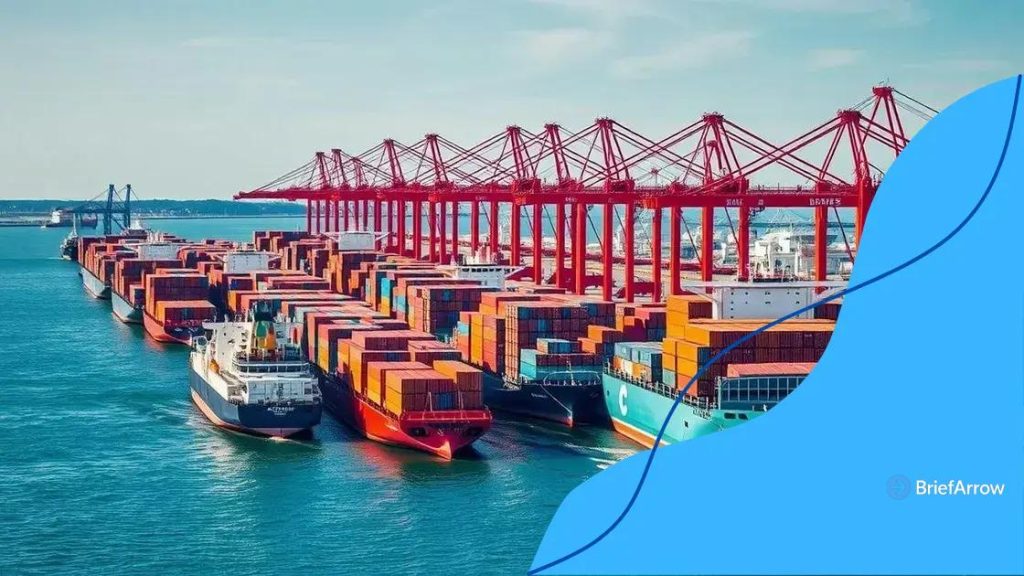Impact of global supply chain issues on prices: a closer look

Anúncios
The impact of global supply chain issues on prices stems from disruptions in logistics, production costs, and market competition, which together drive fluctuations in product availability and pricing for consumers.
Impact of global supply chain issues on prices is a topic that matters to every consumer. Have you noticed the rising costs in your favorite products? It’s not just a coincidence; let’s explore the reasons behind it.
Anúncios
Understanding global supply chain issues
Understanding global supply chain issues is essential in today’s interconnected world. With products flowing across borders, disruptions can have wide-reaching effects. Events like natural disasters, political instability, and pandemics can cause delays, affecting availability and prices.
Key Components of the Supply Chain
A supply chain consists of various stages from production to delivery. Understanding these components helps clarify how disruptions occur.
- Raw materials sourcing
- Manufacturing processes
- Transportation logistics
- Distribution networks
Each of these stages relies on the others. If one segment experiences a problem, it creates a ripple effect, impacting the entire supply chain.
Anúncios
Common Disruptions
Several issues can disrupt the flow of goods. They include labor strikes, environmental events, and changes in trade policies. As we saw during the COVID-19 pandemic, shipping delays dramatically affected prices.
- Labor shortages leading to slowdowns
- Shipping delays caused by port congestions
- Rising fuel costs impacting transportation
These disruptions can lead to higher prices for consumers, as businesses often pass on costs to their customers. Therefore, understanding these dynamics is crucial for making informed purchasing decisions. The interaction of global supply chains with local markets also plays a vital role in how prices are set.
The Importance of Visibility
Gaining visibility into the supply chain can benefit businesses and consumers alike. Companies that track their supply chains can swiftly adapt to changes and mitigate risks. Consumers can be more informed about the products they buy and the reasons behind any price increases.
In summary, understanding global supply chain issues helps us grasp how complex our economy is. From natural calamities to economic shifts, each factor plays a crucial role in shaping market prices.
How disruptions affect consumer prices
How disruptions affect consumer prices is a complex issue that many people are beginning to notice in their daily lives. When there are interruptions in the supply chain, it can lead to noticeable changes in what we pay for goods and services. These disruptions can create uncertainty, pushing prices higher than expected.
Understanding Price Fluctuations
Price fluctuations often reflect changes in supply and demand. For instance, if a natural disaster impacts a region that produces essential goods, the supply may decline. As consumers continue to demand these products, a shorter supply results in higher prices.
- Limited availability of products raises costs.
- Higher shipping charges are passed to consumers.
- Companies raise prices to maintain profits.
When consumers notice higher prices, their spending habits may change. For example, they may begin to look for alternatives or postpone purchases, further affecting demand.
The Role of Market Speculation
Another factor influencing consumer prices is market speculation. Traders can anticipate shortages and increase prices before actual supply disruptions occur. This speculative behavior can lead to inflated prices even before products are genuinely scarce.
Additionally, companies may choose to hedge against future disruptions by raising prices proactively. This creates a frustrating cycle for consumers as they see costs increasing even when there is no immediate shortage of goods.
Influence of Global Events
Global events, such as trade wars or pandemics, significantly impact prices. When countries impose tariffs or face shipping delays, the cost of imported goods rises. This can directly affect consumers, as local retailers must adjust their pricing models.
- Tariffs on imports can lead to increased retail prices.
- Shipping delays cause increased operational costs.
- Consumer choice becomes limited in times of crisis.
Many consumers may not realize how these factors impact their wallets until they see a noticeable difference in prices at their local stores. The interplay of disruptions and their effect on consumer prices reveals how interconnected our economy has become.
Key factors driving price changes

Key factors driving price changes can have a profound impact on what consumers pay for products and services. Understanding these factors helps to better navigate the complexities of pricing in today’s market.
Supply and Demand Dynamics
The relationship between supply and demand is a fundamental principle that influences prices. When demand for a product increases but supply remains the same, prices are likely to rise. Conversely, if there is an oversupply of goods, sellers may lower prices to attract buyers.
- High demand with low supply increases prices.
- Low demand with high supply decreases prices.
- Seasonal trends affect consumer interest.
For example, during holiday seasons, demand for certain gifts spikes, leading retailers to adjust their prices upward. Staying aware of these trends can help consumers time their purchases better.
Production Costs
Another crucial factor is the cost of production, which includes raw materials, labor, and overhead costs. If any of these costs rise, businesses may pass those increases onto consumers. For instance, a surge in oil prices can raise transportation costs, leading to higher prices for goods across the board.
- Increased raw material costs lead to higher prices.
- Labor shortages can push wages up.
- Manufacturing disruptions can cause costs to spike.
These rising production costs can cause ripple effects throughout the economy, impacting everything from groceries to electronics.
Market Competition
The level of competition in a market also plays a significant role in driving prices. In highly competitive markets, businesses may keep prices lower to attract more customers. However, monopolies or oligopolies can lead to higher prices as competition diminishes.
- High competition often results in lower prices.
- Monopolies can lead to price gouging.
- Market entry of new competitors can disrupt pricing.
As new players enter the market or existing companies innovate, consumers may see price variations that reflect these changes. Understanding the competitive landscape can help consumers make informed buying choices.
External Factors
External factors like government policies and international relations also influence prices. Tariffs on imports can lead to higher costs for consumers, while changes in trade agreements can impact availability and pricing.
Being aware of these key factors driving price changes helps consumers understand why they pay what they do. Navigating these aspects of the economy becomes easier with knowledge of the underlying dynamics affecting their wallets.
The role of logistics in pricing
The role of logistics in pricing is a critical aspect of how businesses determine what consumers pay for their products. Efficient logistics can lead to lower costs, while poor logistics can result in higher prices.
Understanding Logistics
Logistics involves the planning and execution of moving goods from the point of origin to the consumer. It includes everything from transportation and warehousing to inventory management. Efficient logistics ensure products arrive on time and in good condition, which can directly influence pricing.
- Transportation efficiency reduces costs.
- Effective inventory management improves availability.
- Warehousing strategically located cuts delivery times.
When logistics run smoothly, businesses can lower prices to attract more customers. However, when logistics fail, costs can escalate quickly, impacting what the consumer ends up paying.
Impact of Transportation Costs
Transportation plays a significant role in logistics and, therefore, pricing. Fuel prices, vehicle maintenance, and driver wages affect transportation costs, which are often passed on to consumers. If shipping costs rise due to increased fuel prices, for example, businesses may increase their prices.
- Higher fuel prices lead to increased shipping costs.
- Longer delivery routes can raise overall expenses.
- Increased tolls or tariffs affect shipping choices.
Consumers often feel the burden of these increased costs, making them more discerning in their purchasing decisions. Choices like delivery options can lead to varied price points for the same item.
Technology in Logistics
Technology also plays a significant role in logistics. Innovations such as tracking systems and automated warehouses improve efficiency. By utilizing technology, businesses can lower costs and streamline operations, which can positively impact pricing.
Additionally, data analytics helps companies anticipate demand. This allows for better management of inventory and reduces the chances of excess costs due to overstocking or stockouts. These savings can be reflected in lower prices for consumers.
Challenges in Logistics
Despite the benefits, logistics can face challenges such as supply chain disruptions, natural disasters, or geopolitical issues. These challenges can lead to increased costs, which are inevitably passed on to consumers. When logistics operations are hindered, shortage situations arise, leading to price hikes.
Understanding the role of logistics in pricing is vital for consumers and businesses alike. Efficient logistics not only create better pricing strategies but also contribute to overall customer satisfaction by ensuring products are available when needed.
Future trends in supply chain management
Future trends in supply chain management are crucial for understanding how businesses will operate in an increasingly global marketplace. As technology evolves, so do the strategies used to manage supply chains efficiently.
Increased Use of Automation
One of the most significant trends is the increase in automation. Businesses are adopting automated technologies to streamline operations and reduce costs. Automation can help manage inventory, process orders, and optimize logistics pathways.
- Automated warehouses improve efficiency.
- Robotics streamline manufacturing processes.
- Smart systems predict inventory needs.
This shift toward automation not only speeds up operations but also helps reduce human error, leading to more accurate inventory management and order fulfillment.
Sustainability Initiatives
Sustainability is becoming a paramount concern for many consumers and businesses. Future supply chains are likely to place a greater emphasis on environmentally friendly practices. Companies are working to reduce their carbon footprints by adopting sustainable sourcing and transportation methods.
- Using eco-friendly materials.
- Reducing waste in production processes.
- Implementing energy-efficient logistics.
These initiatives help businesses appeal to environmentally conscious consumers while also contributing to regulatory compliance.
Data-Driven Decision Making
The use of data analytics is revolutionizing supply chain management. Businesses are increasingly relying on data to make informed decisions. This allows for better demand forecasting, supplier selection, and inventory management.
By analyzing trends and patterns, companies can predict fluctuations in supply and demand more accurately. This leads to proactive strategies that minimize disruptions. For example, advanced analytics can identify potential supply chain risks before they become critical.
Personalization and Customization
As consumers demand more personalized products and services, supply chains will need to adapt accordingly. Companies are exploring ways to customize offerings without significantly increasing costs or complexity.
- Flexible manufacturing processes allow for customization.
- Real-time inventory tracking supports personalized orders.
- Consumers are looking for unique experiences.
This trend towards customization creates new challenges but also opportunities for differentiation in the marketplace. Businesses that can adapt quickly will likely gain a competitive edge.
Understanding these future trends in supply chain management helps businesses and consumers navigate the evolving market landscape. As companies innovate and adapt, the dynamics of supply chains will continue to transform, influencing everything from product availability to pricing.
FAQ – Frequently Asked Questions about the Impact of Global Supply Chain Issues on Prices
How do supply chain disruptions affect product availability?
Supply chain disruptions can lead to shortages of goods, making them harder to find and possibly driving prices higher due to increased demand.
What role does logistics play in determining prices?
Logistics affect prices by influencing transportation costs and delivery times. Efficient logistics can lower costs and help keep prices competitive.
How can companies adapt to rising production costs?
Companies can adapt by optimizing their supply chains, negotiating better rates with suppliers, or passing some costs to consumers through price adjustments.
What trends should consumers watch in supply chain management?
Consumers should pay attention to trends like automation, sustainability initiatives, and data-driven decision making, as these can directly impact product pricing and availability.